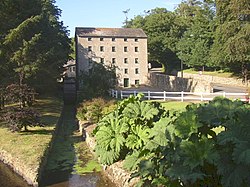Foulkesmill
| Foulkesmill Irish: Muileann Fúca | |
| County Wexford | |
|---|---|
 Corn mill at Foulkesmill | |
| Location | |
| Grid reference: | SL761790 |
| Location: | 52°18’51"N, 6°45’11"W |
| Data | |
| Local Government | |
Foulkesmill or Foulkesmills is a small village in the south of County Wexford.
History
The Irish name Muileann Fúca was historically anglicised as Mullinfooky.[1] The name is however English, from Sir Foulkes Furlong (fl. 1410) who was Seneschall of Bree.
A battle was fought near here on 20 June 1798, during the Irish Rebellion of 1798. It is known as the Battle of Horetown (or Goff's Bridge, or Foulksmills). A large contingent of United Irishmen armed with pikes engaged in battle a smaller British Crown force armed with rifles and cannon, commanded by General John Moore; both sides withdrew after heavy fighting.
Lewis’s Topographical Dictionary of Ireland (1837)[2] has the following entry regarding Foulkesmill:
FOOK'S MILLS, a village, partly in the parish of CLONGEEN, and partly in that of HORETOWN, barony of SHELMALIER, county of WEXFORD, and province of LEINSTER, 3½ miles (S. W.) from Taghmon, on the old mail road to New Ross : the population is returned with the respective parishes. It contains about 30 houses, including a good country inn, where the meetings of the South Wexford Agricultural Association are occasionally held. In the immediate vicinity are Rosegarland, the seat of F. Leigh, Esq., and Horetown Glebe, the residence of the Rev. E. Bayley.[2]
References
- ↑ Muileann Fúca: Placenames Database of Ireland
- ↑ 2.0 2.1 Samuel Lewis (1837). Topographical Dictionary of Ireland, Vol. I (1st Edition, 1837). London: S. Lewis & Co. pp. 632–33.